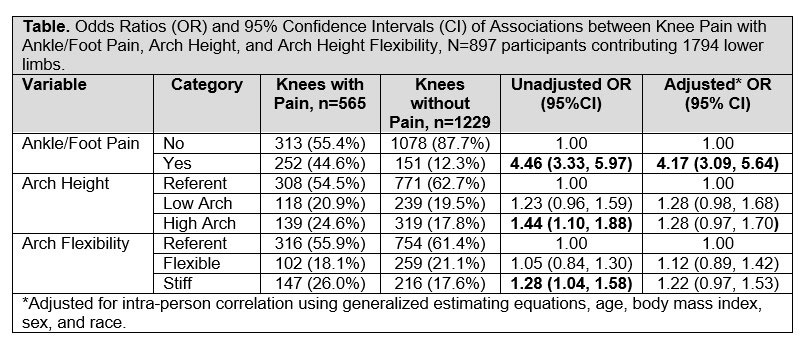Session Information
Session Type: Poster Session D
Session Time: 1:00PM-3:00PM
Background/Purpose: In knee osteoarthritis (OA), the contribution of the ankle and foot up the kinetic chain to the knee is not well understood. Ankle and foot pain have been shown to be related to knee pain among individuals at risk for or with knee OA, but the association is not established in the broader population. Also, it is not known if other ankle and foot conditions (including arch disorders) could amplify knee pain. The purpose of this study was to determine the cross-sectional associations between knee pain and ankle/foot pain, arch height, and arch flexibility in a community-based cohort.
Methods: Participants were from the 2013-2015 study visit of the Johnston County Osteoarthritis Project, a cohort of White and Black men and women with and without OA from a mostly rural county in North Carolina. Presence of knee, ankle, or foot pain (yes/no) was assessed by the question: “On most days, do you have pain, aching or stiffness in your left/right knee/ankle/foot?” Using the Arch Height Index Measurement System, arch height and truncated foot length (mm) of each foot were assessed with the participant sitting and standing. Arch height index was calculated as arch height divided by truncated foot length to determine low and high arches defined as the lowest or highest quintiles of the total sample, respectively. Arch height flexibility (mm/kN) was calculated as the change in arch height between sitting and standing conditions, normalized to the change in load, estimated as 40% of body weight. Arches were categorized as either stiff or flexible if they were in the lowest or highest quintiles of the sample, respectively. At the lower limb level, separate logistic regression models with generalized estimating equations to account for intra-person correlations were used to estimate associations between knee pain and: i) ankle/foot pain, ii) arch height, and iii) arch height flexibility, adjusting for age, body mass index (BMI), sex, and race.
Results: Of the 907 participants who attended the clinic study visit, 897 had complete data on knee, ankle, and foot pain and arch height (mean age 71 ± 8 years, mean BMI 31 ± 6 kg/m2, 68% were women, 34% were Black). Among lower limbs in this analysis, 31.4% had knee pain and 22.4% had ankle/foot pain (17.4% ankle pain, 20.4% foot pain). In unadjusted models, knee pain was associated with ankle/foot pain (odds ratio [OR] 4.46, 95% confidence interval [CI] 3.33, 5.97), high arches (OR 1.44, 95%CI 1.10, 1.88), and stiff arches in the same limb (OR 1.28, 95%CI 1.04, 1.58, Table). In adjusted models, the strong association between knee pain and ankle/foot pain persisted (OR 4.17, 95%CI 3.09, 5.64). Associations with high arches and stiff arches were attenuated but still demonstrated a positive relationship. There also was an association with low arches, although not statistically significant.
Conclusion: Ankle and foot conditions appear to amplify ipsilateral knee pain and as such, these findings underscore the need to consider the ankle/foot when considering knee pain in the community. Examination of the interplay between ankle/foot conditions (e.g., pain, OA, biomechanical anomalies) and their role in knee pain is needed to inform treatment.
To cite this abstract in AMA style:
Golightly Y, Hannan M, Hillstrom H, Hillstrom R, Minnig M, Nelson A. Knee Pain Is Highly Associated with Ankle/Foot Pain, Arch Height, and Arch Flexibility: The Johnston County Osteoarthritis Project [abstract]. Arthritis Rheumatol. 2022; 74 (suppl 9). https://acrabstracts.org/abstract/knee-pain-is-highly-associated-with-ankle-foot-pain-arch-height-and-arch-flexibility-the-johnston-county-osteoarthritis-project/. Accessed .« Back to ACR Convergence 2022
ACR Meeting Abstracts - https://acrabstracts.org/abstract/knee-pain-is-highly-associated-with-ankle-foot-pain-arch-height-and-arch-flexibility-the-johnston-county-osteoarthritis-project/

